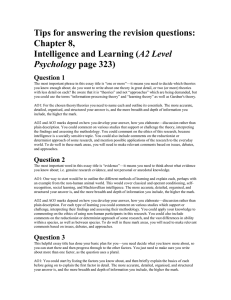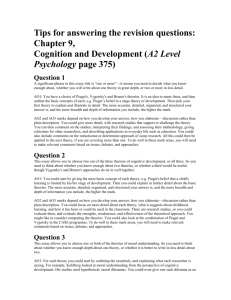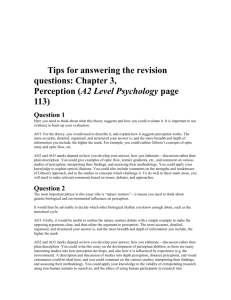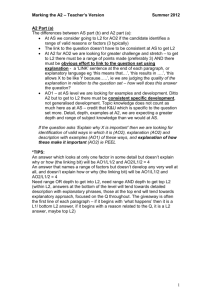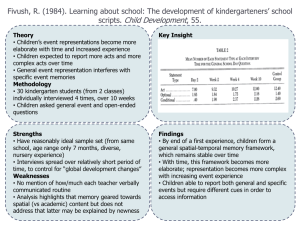Tips for answering the revision questions: Chapter 7
advertisement
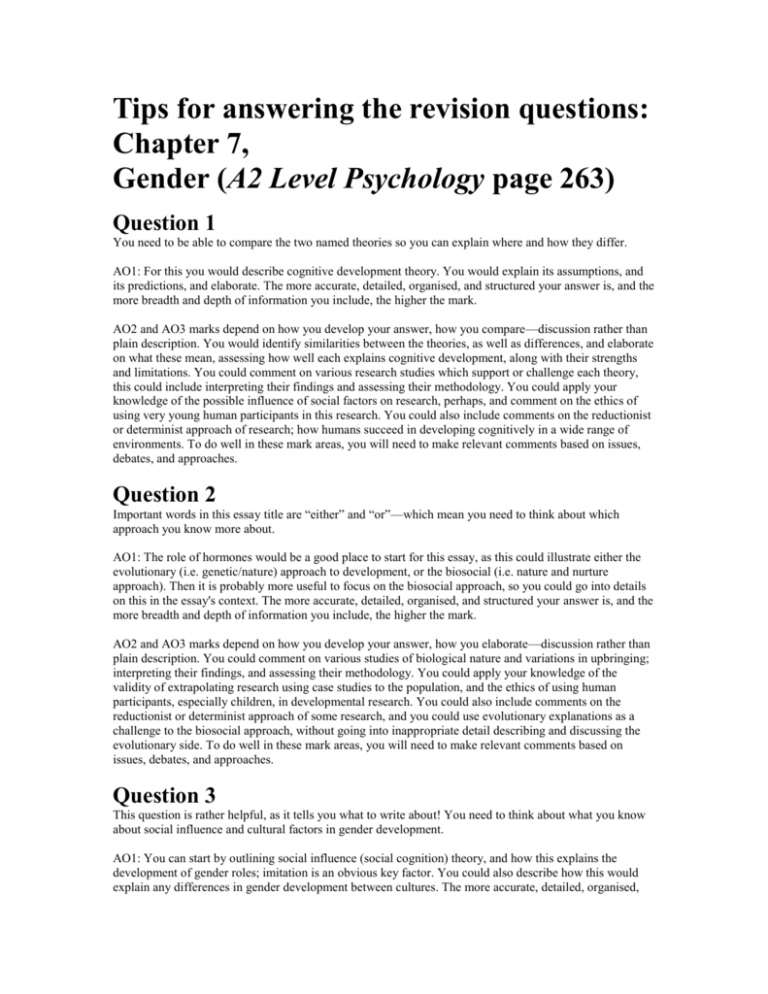
Tips for answering the revision questions: Chapter 7, Gender (A2 Level Psychology page 263) Question 1 You need to be able to compare the two named theories so you can explain where and how they differ. AO1: For this you would describe cognitive development theory. You would explain its assumptions, and its predictions, and elaborate. The more accurate, detailed, organised, and structured your answer is, and the more breadth and depth of information you include, the higher the mark. AO2 and AO3 marks depend on how you develop your answer, how you compare—discussion rather than plain description. You would identify similarities between the theories, as well as differences, and elaborate on what these mean, assessing how well each explains cognitive development, along with their strengths and limitations. You could comment on various research studies which support or challenge each theory, this could include interpreting their findings and assessing their methodology. You could apply your knowledge of the possible influence of social factors on research, perhaps, and comment on the ethics of using very young human participants in this research. You could also include comments on the reductionist or determinist approach of research; how humans succeed in developing cognitively in a wide range of environments. To do well in these mark areas, you will need to make relevant comments based on issues, debates, and approaches. Question 2 Important words in this essay title are “either” and “or”—which mean you need to think about which approach you know more about. AO1: The role of hormones would be a good place to start for this essay, as this could illustrate either the evolutionary (i.e. genetic/nature) approach to development, or the biosocial (i.e. nature and nurture approach). Then it is probably more useful to focus on the biosocial approach, so you could go into details on this in the essay's context. The more accurate, detailed, organised, and structured your answer is, and the more breadth and depth of information you include, the higher the mark. AO2 and AO3 marks depend on how you develop your answer, how you elaborate—discussion rather than plain description. You could comment on various studies of biological nature and variations in upbringing; interpreting their findings, and assessing their methodology. You could apply your knowledge of the validity of extrapolating research using case studies to the population, and the ethics of using human participants, especially children, in developmental research. You could also include comments on the reductionist or determinist approach of some research, and you could use evolutionary explanations as a challenge to the biosocial approach, without going into inappropriate detail describing and discussing the evolutionary side. To do well in these mark areas, you will need to make relevant comments based on issues, debates, and approaches. Question 3 This question is rather helpful, as it tells you what to write about! You need to think about what you know about social influence and cultural factors in gender development. AO1: You can start by outlining social influence (social cognition) theory, and how this explains the development of gender roles; imitation is an obvious key factor. You could also describe how this would explain any differences in gender development between cultures. The more accurate, detailed, organised, and structured your answer is, and the more breadth and depth of information you include, the higher the mark. AO2 and AO3 marks depend on how you develop your answer, how you elaborate—discussion rather than plain description. You could comment on other social explanations that challenge social learning, such as conditioning, and discuss various studies into the effect of role models and of the media, interpreting their findings and assessing their methodology. You could apply your knowledge of the validity of extrapolating research, using small or biased samples, to the population at large, and of the ethics of using very young humans in such research. You could also comment on the reductionist or determinist approach of some research, and include discussion of cross-cultural studies and their strengths and weaknesses, as well as how humans manage to develop successfully in a wide variety of environments. To do well in these mark areas, you will need to make relevant comments based on issues, debates, and approaches. Question 4 A very important word in this essay title is “and”—it means you need to think about what you know enough about each term, and how you will balance your essay. You don’t need to write the same amount about each, but you do need to write about both. AO1: One place to start would be to explain the characteristics of each. For androgyny, you could describe Bem's research. For gender dysphoria, you could explain that there are biological and non-biological explanations. The more accurate, detailed, organised, and structured your answer is, and the more breadth and depth of information you include, the higher the mark. AO2 and AO3 marks depend on how you develop your answer, how you elaborate—discussion rather than plain description. You could comment on various studies of Bem's viewpoint, interpreting their findings, and assessing their methodology, and discuss the disagreements regarding Bem’s categories, which make drawing reliable conclusions difficult. You could then apply your knowledge to neurobiological explanations of gender dysphoria, and discuss how these can explain many, but not all, cases. You may wish to also consider the methodological and ethical issues in this highly personal and sensitive research area. You could also comment on the reductionist or determinist approach of some research, as well as the underestimating of possible biological causes by the social (i.e. family) theorists. To do well in these mark areas, you will need to make relevant comments based on issues, debates, and approaches.

